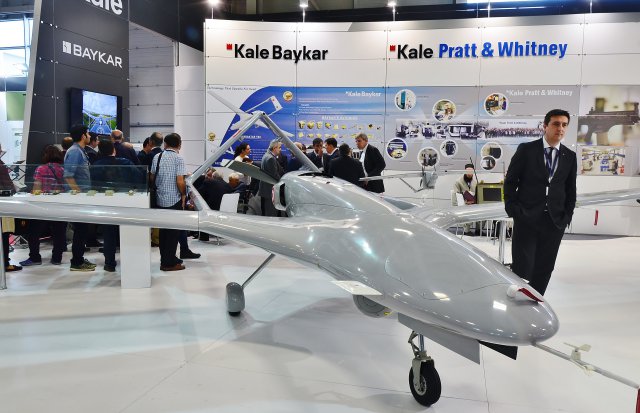
With Turkish officials acknowledging the operational-level service of the Bayraktar TB2, Turkey becomes just the sixth nation in the world to field a viable Unmanned Aerial Combat Vehicle (UCAV). It joined the United States, China, Pakistan, Israel and Iran in the field. These platforms offer considerable advantages when compared to their Unmanned Aerial Vehicle (UAV) brethren – least of these being an armed ability to seek out and destroy ground elements with precision strikes without exposing human airmen or their very expensive flying machines to danger.
The TB2 is based on the earlier Bayraktar Tactical UAS first flown in 2009 and introduced in 2014. The TB2 is the “armed reconnaissance” form and has already seen successful action against PKK (Kurdistan Workers Party) forces – the series’ first “kill” was recorded on September 8th, 2016 and many more have followed since.
Turkey has tried, for years, to secure foreign-born UCAV platforms, from the United States and elsewhere, to no avail. As such it turned to local industry to develop an indigenous solution to an indigenous problem and this has led to several notable products emerging: the TAI Anka (detailed elsewhere on this site) and the TB2. The TB2 gained steam in 2015 as a weapons-delivery capability was fleshed out for the Bayraktar Tactical UAS. This led to trials in late 2015 and formal introduction for service in 2016. With all of the work being local in nature, Turkey bypasses any strict arms regulations generally encountered with foreign purchases. Additionally, the TB2 can be evolved as Turkish military needs require making for a more effective long-term solution.
The finalized TB2 sees straight wing mainplanes positioned at midships and aft of a sleek nosecone assembly. The engine is fitted at the rear of the fuselage within a well-contoured housing – aspiration of the powerplant is through small slits on the housing surfaces. The engine powers a two-bladed propeller unit in “pusher” configuration. A twin-boom tail design is used to help clear the engine installation and its propeller. The booms are slim and emanate from the wing root trailing edges, joined together at the rear of the aircraft by conjoined, inward-cranked vertical tail fins also serving as de facto horizontal planes. The wheeled undercarriage is fixed in flight and an optics blister is seen at the ventral line of the fuselage.
By all accounts, the TB2 utilizes proven UAV design and construction practices – from its external arrangement to its internal make-up. It is further classified as a Medium-Altitude, Long-Endurance (MALE) unmanned system. Operators pilot the aircraft from Ground Control Stations (GCSs) and some autonomous capability is built into the flying component.
The aircraft features a pair of hardpoints under the wings, one per wing, that allow for the carrying of various ordnance types including Anti-Tank Guided Missiles (ATGMs) as well as Laser-Guided Bombs (LGBs). All this adds to the precision strike capability so sought after by today’s militaries. Beyond the ability to self-designate and strike at ground targets, the series has also been used to laser-designate missile targets for Turkish Army attack helicopters like the American-made HueyCobra.
The TB2 was successfully tested with the UMTAS anti-tank missile on December 17th, 2015.
Six UAVs were delivered to the Turkish Land Forces by 2014 while a second batch of six was handed over in June 2015.
The redundant flight control system allows autonomous taxi, take-off, navigation, landing and parking operations without assistance from any external sensor. The unmanned vehicle is also capable of employing semi-auto modes during missions.
The tactical UAV has a range of more than 150km and can fly at a maximum altitude of 22,500ft. It has a maximum speed of 70kt and endurance of more than 20 hours.
Each Bayraktar TB2 system consists of six aerial vehicles, two ground control stations (GCS), three ground data terminals (GDTs), two remote video terminals (RVTs) and ground support equipment.
The UAV has a length of 6.5m, wing span of 12m and a maximum take-off weight of 630kg.
It is equipped with a triple redundant avionics system. An on-board avionics suite encompasses units, including micro-controller, engine control, servo motor power control, engine signal processing and I/O and GPS receiver units.
Bayraktar TB2 UAV can carry a maximum payload of more than 55kg. The standard payload configuration includes an electro-optical (EO) camera module, an infrared (IR) camera module, a laser designator, a laser range finder (LRF) and a laser pointer.
The ground control station is based on a NATO spec ACE-III mobile shelter unit.
Source: i-HLS
